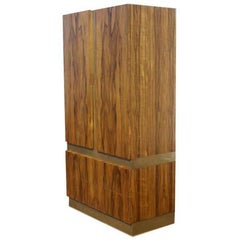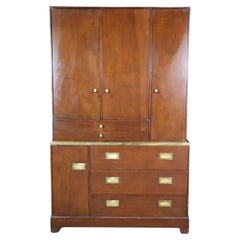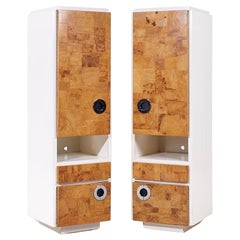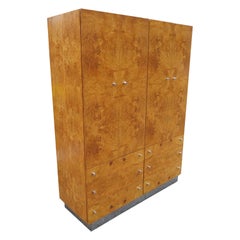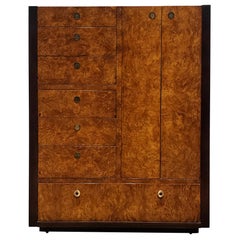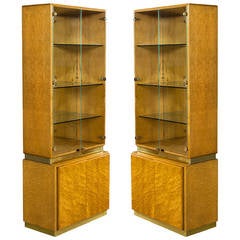Milo Baughman Armoire
Mid-20th Century American Mid-Century Modern Wardrobes and Armoires
Rosewood
Mid-20th Century Mid-Century Modern Wardrobes and Armoires
Walnut
Vintage 1970s American Modern Wardrobes and Armoires
Steel, Brass
Vintage 1970s American Mid-Century Modern Wardrobes and Armoires
Burl, Lacquer
Vintage 1970s American Mid-Century Modern Cabinets
Chrome
Vintage 1980s American Art Deco Dressers
Burl, Lacquer
Recent Sales
Mid-20th Century American Mid-Century Modern Wardrobes and Armoires
Brass
Vintage 1960s Art Deco Cabinets
Vintage 1960s American Mid-Century Modern Wardrobes and Armoires
Brass
Late 20th Century American Mid-Century Modern Wardrobes and Armoires
Brass
Vintage 1970s American Mid-Century Modern Wardrobes and Armoires
Metal
Mid-20th Century Canadian Mid-Century Modern Wardrobes and Armoires
Wood
Vintage 1970s American Mid-Century Modern Wardrobes and Armoires
Burl
Vintage 1960s American Mid-Century Modern Wardrobes and Armoires
Brass
Vintage 1970s American Mid-Century Modern Wardrobes and Armoires
Burl
Vintage 1970s Modern Wardrobes and Armoires
Burl
Vintage 1970s American Mid-Century Modern Wardrobes and Armoires
Walnut
Vintage 1970s American Campaign Wardrobes and Armoires
Brass
Vintage 1970s American Scandinavian Modern Wardrobes and Armoires
Burl
Mid-20th Century Canadian Mid-Century Modern Wardrobes and Armoires
Chrome
Vintage 1980s American Mid-Century Modern Wardrobes and Armoires
Ash, Burl, Ebony
Vintage 1970s American Mid-Century Modern Wardrobes and Armoires
Burl
Vintage 1970s American Mid-Century Modern Wardrobes and Armoires
Burl
Mid-20th Century American Mid-Century Modern Wardrobes and Armoires
Walnut
Vintage 1970s American Mid-Century Modern Wardrobes and Armoires
Stainless Steel
Vintage 1980s American Mid-Century Modern Linen Presses
Ash, Ebony, Burl
Vintage 1970s North American Mid-Century Modern Dressers
Burl
Vintage 1970s American Mid-Century Modern Dressers
Burl
Vintage 1970s American Mid-Century Modern Dressers
Ash, Olive, Burl
Vintage 1970s American Mid-Century Modern Wardrobes and Armoires
Metal
Vintage 1960s American Mid-Century Modern Wardrobes and Armoires
Brass
Vintage 1960s American Mid-Century Modern Wardrobes and Armoires
Steel
Mid-20th Century North American Mid-Century Modern Wardrobes and Armoires
Brass
Vintage 1970s American Mid-Century Modern Wardrobes and Armoires
Burl
Vintage 1970s Mid-Century Modern Wardrobes and Armoires
Wood, Burl
Vintage 1980s American Mid-Century Modern Wardrobes and Armoires
Ash, Burl
20th Century Mid-Century Modern Wardrobes and Armoires
Walnut
Vintage 1970s American Mid-Century Modern Wardrobes and Armoires
Rosewood
Vintage 1970s Mid-Century Modern Wardrobes and Armoires
Burl
Mid-20th Century American Mid-Century Modern Dressers
Ash, Olive, Burl
20th Century American Mid-Century Modern Dressers
Walnut
Vintage 1960s American Wardrobes and Armoires
Brass
Vintage 1960s American Mid-Century Modern Wardrobes and Armoires
Chrome
Vintage 1970s American Wardrobes and Armoires
Steel
Vintage 1970s American Wardrobes and Armoires
Vintage 1970s American Mid-Century Modern Cabinets
Vintage 1970s American Wardrobes and Armoires
Walnut, Beech
People Also Browsed
2010s Italian Mid-Century Modern Chandeliers and Pendants
Steel
Early 2000s Italian Mid-Century Modern Chandeliers and Pendants
Brass
Vintage 1970s American Sofas
Velvet, Rattan
21st Century and Contemporary Brazilian Modern Carts and Bar Carts
Steel
2010s South African Modern Chairs
Steel
21st Century and Contemporary British Chinoiserie Wallpaper
Paper
Vintage 1970s American Mid-Century Modern Sofas
Velvet, Lucite
Antique 19th Century British Neoclassical Dining Room Tables
Brass
2010s Italian French Provincial Pillows and Throws
Fabric
Mid-20th Century French Mid-Century Modern Sofas
Fabric
20th Century American Mid-Century Modern Sofas
Fabric, Cane, Rattan, Hardwood
20th Century Mid-Century Modern Coffee and Cocktail Tables
Glass, Burl
Vintage 1970s Danish Mid-Century Modern Sofas
Chrome
Vintage 1950s English Mid-Century Modern Bookcases
Oak, Plywood
Vintage 1970s Mid-Century Modern Swivel Chairs
Chrome
Vintage 1950s American Mid-Century Modern Bookcases
Walnut
Finding the Right Wardrobes-armoires for You
When shopping for antique and vintage wardrobes and armoires for your home, there are several things to keep in mind, not least of which is question number 1:
What is the difference between an armoire and a wardrobe?
The difference between an armoire and a wardrobe is actually simple: An armoire is merely an ornate wardrobe. A wardrobe is a tall, streamlined storage cabinet that usually has some combination of drawers, shelves and hanging rods.
Antique and vintage armoires, on the other hand, are freestanding, heavy wooden structures that typically feature decorative metal hinges and pictorial carvings. Armoires are large cabinets that aren’t outfitted with the varied storage features that wardrobes now commonly have. Armoires often have one or two doors and a hanging bar and allow for quick access. Whether a minimalist mid-century modern wardrobe or grandiose Victorian-era armoire is the right fit for you, both are highly functional furnishings and can be a smart storage solution.
Armoires have been around since medieval times, and initially they may have housed weapons and armor. In their early days, armoires were often adorned with elaborate carvings and lavish paintings, particularly in Renaissance-era France. During the 18th century and later, armoires were widely known as “presses” for hanging clothes, and they were so large that they swallowed up the room where they stood.
In today’s modern homes, an antique armoire can be a striking, architectural work of art amid comparably unadorned furnishings. Whether you’re using your piece in the kitchen for cookware or as a food pantry, in the bedroom for clothes or in the living room as a media console, it will likely become a lovable focal point.
The evolution of the armoire can be seen in today’s corner wardrobes, which may rest on an asymmetrical base to account for corner placement, and even mirrored wardrobes, which feature a mirror affixed to the inside panel of one of the doors for convenience. Contemporary wardrobes commonly feature additional sliding trays and drawers and hanging space for clothing or linens, and the cabinet doors make them ideal for concealing televisions and computer monitors when such devices aren’t in use.
When choosing the right wardrobe or vintage armoire for your home, it’s good to have the following in mind: What are you planning to store in it? How much of what you’re storing will need to be housed in it? It should be big enough to accommodate your needs. What is the size of the room where your wardrobe or armoire will live? A large new piece of furniture in a modest space can easily become a hindrance if you have to navigate your way around it during your daily routine, so be mindful of the area you'll need in order to move freely.
Whether you are looking for an antique walnut armoire or a simple contemporary wardrobe, find the right piece for your home today on 1stDibs.
- Who is Milo Baughman?1 Answer1stDibs ExpertMarch 22, 2022Milo Baughman was an American furniture designer whose pieces helped define the trends of the 1970s. His style features sleek, simple lines with little ornamentation. In addition to creating furniture, Baughman taught design at Brigham Young University. Find a collection of Milo Baughman on 1stDibs.
- 1stDibs ExpertMarch 22, 2022To pronounce Milo Baughman, say "MY-low BA-mun." The "GH" in his surname is silent. Baughman was born in 1923 in Goodland, Kansas, but he soon moved to California, the state that served as his home throughout much of his life. Shop a large selection of Milo Baughman furniture on 1stDibs.
- 1stDibs ExpertMarch 22, 2022Milo Baughman designed furniture for Thayer Coggin from 1953 to 2003. The brand produced most pieces from their joint collection in High Point, North Carolina, and the range includes a variety of chairs, sofas and tables. You'll find a collection of Milo Baughman for Thayer Coggin furniture on 1stDibs.
- 1stDibs ExpertMarch 22, 2022How best to identify Milo Baughman furniture depends on the piece. Lounge chairs and sofas often feature a flat metal bar frame, and his tables tend to show off clean, simple lines. The backs of Baughman's pieces make the same visual impression as the fronts because he believed that furniture should be pleasing to the eye when viewed from any angle. Find a large selection of expertly vetted Milo Baughman furniture on 1stDibs.
- 1stDibs ExpertApril 5, 2022Milo Baughman took special care to make sure his chairs looked just as good from the back as they do from the front. You can spot a real Milo Baughman chair by checking out the trademark flat bar metal frames on the chairs and sofas. Shop a collection of Milo Baughman pieces from some of the world’s top sellers on 1stDibs.
- 1stDibs ExpertAugust 26, 2024How to tell if a Milo Baughman is real will differ depending on the type of piece. If you're trying to authenticate a chair, look for the flat metal bar frame that is indicative of the designer’s work. For casegoods and tables, every inch of the surface should be finished. Baughman believed that even the backs of bookcases and cabinets should be as visually appealing as their fronts. Studying images of genuine pieces published at trusted online resources can also be helpful when authenticating any type of Milo Baughman furniture. If you need assistance verifying authenticity, consult a certified appraiser or knowledgeable antiques dealer. On 1stDibs, explore a selection of Milo Baughman furniture.
- 1stDibs ExpertApril 5, 2022Milo Baughman designed for many companies over the course of his life. Some of the companies the American designer worked for include Arch Gordon, Directional Furniture, Drexel, George Kovacs, Glenn of California, The Inco Company, Mode Furniture, Murray Furniture of Winchendon and Pacific Iron. You'll find a collection of Milo Baughman furniture on 1stDibs.
- 1stDibs ExpertMarch 22, 2022Whether Milo Baughman recliners are comfortable or not is largely a matter of personal perception. However, creating furniture that was as functional as it was fashionable was his main goal. You can see this reflected in the ample padding, supportive lines and carefully selected upholstery of his recliners. Shop a range of Milo Baughman recliners on 1stDibs.
- 1stDibs ExpertMarch 22, 2022Milo Baughman made chairs out of a variety of materials. Many of his pieces feature metal bar frames fashioned out of chrome, brass or stainless steel. Milo Baughman chairs often have leather upholstery. However, you may also find reupholstered pieces clad in various fabrics. Shop a large selection of Milo Baughman chairs on 1stDibs.
- 1stDibs ExpertMarch 22, 2022One way to know if a piece of furniture is a Milo Baughman for Thayer Coggin is to consult the visual catalog of his pieces on the Thayer Coggin official website. Many of the chairs he produced for the brand feature metal bar or pedestal bases. In addition, he created many drum tables for Thayer Coggin. You'll find a large collection of expertly vetted Milo Baughman for Thayer Coggin pieces on 1stDibs.
